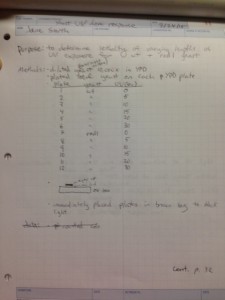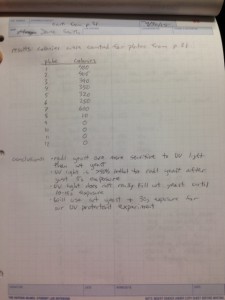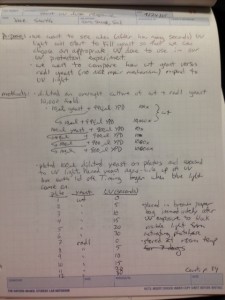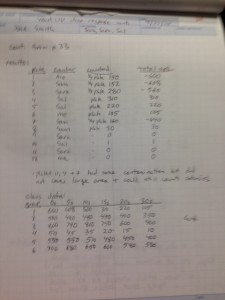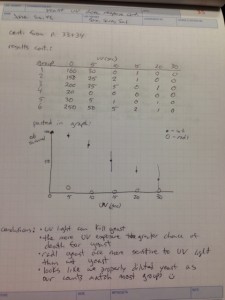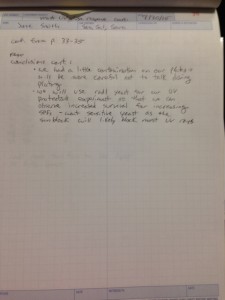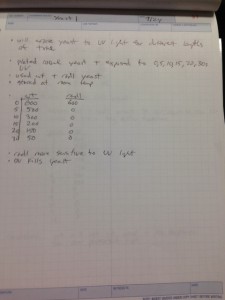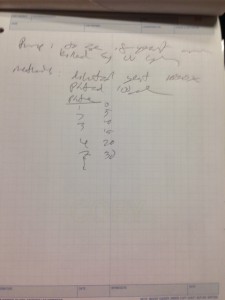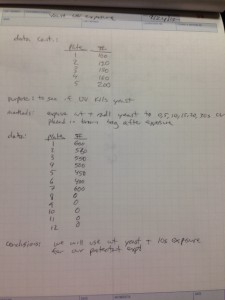The following example notebook entries are from an experiment where wild type and rad1 mutant yeast were plated, exposed to varying amounts of UV light, allowed to grow for one week, and then surviving yeast colonies were counted.
Example 1 (concise & complete):
This notebook entry does not have a lot of extra text or content but contains all the necessary information to understand why they did the experiment (purpose), how they did the experiment (methods), what they found (results), and what their findings meant (conclusions). The title is informative and the purpose clearly explains why they were doing this experiment. Their methods have enough detail (like the dilution factor for the yeast and how much they plated) for someone to replicate this experiment. The notebook is organized – their title (which would be in their table of contents) would make it easy for someone interested in knowing how yeast respond to various doses of UV light to find this experiment and their sections in the entry are well-labeled so someone could quickly jump to the section they care about (perhaps methods if they wanted to redo the experiment or results if they wanted to use the data to help them choose a UV dose to use in their experiment). Their results have the raw data (colony counts) and their conclusions are clearly stated.
Example 2 (lovely notebook):
This notebook has all the necessary information (like in example 1) but gives a little detail that would help anyone reading this notebook easily follow the entire experiment.
They clearly separated the multiple purposes for carrying out the experiment. They included their actual dilution volumes used (this can be handy both to double check your calculation accuracy if after getting your results your yeast concentration was off, and to save yourself the time of having to redo these same calculations in the next lab). Having your volumes written down (in your notebook or on a scrap paper) also reduces the chance of you absentmindedly using the wrong volume when actually pipetting.
Their methods section also includes useful information/tips that would help anyone trying to replicate the experiment (like how to place yeast on the UV box and that time began when the blue light came on). They also include some reasoning to explain their methods (like why the yeast were placed in the brown bag) which would help someone replicating the experiment recognize vital experimental details (that the yeast must be kept in the dark).
Their notebook also makes it very easy to follow the experiment from page to page by marking on each page where it continues and where it continued from (this can be especially useful for experiments that have long – say months – of incubation before you collect the data). The title also makes it clear which pages are continuations.
Their results have the raw data (this is necessary), as well as information on how the data was collected that could be useful. Like who counted in case different partners have different counting biases if say one counted teeny tiny colonies and another did not. They also noted how each plate was counted so it is obvious which ones should be very accurate (entire plate counted) and which ones may have larger error (only ¼ of the plate was counted). Their results also includes data from other groups. Even though this is not their own data it is useful to help interpret the experiment so is helpful to include. Data analyses (such as graphs) are also included which would save someone from redoing the analyses if they were interested in these results and also makes it easier to evaluate the conclusions drawn.
Their conclusions are organized into separate thoughts and include not only conclusions for their original purpose questions but also thoughts on their technique.
Example 3 (too minimal):
This notebook is lacking detail. Although the level of detail is enough for the researcher to understand exactly what they did and what they found for several weeks after the experiment, if they were to come back to it 2 years later they would likely have a hard time replicating the exact same experiment or making sense of the data. The title (yeast 1) should be more descriptive. The main purpose of the title is to identify the experiment clearly enough that someone searching the table of contents (with say 100 different experiments listed all likely related to yeast and UV) could easily determine which experiment they are interested in when searching for something specific (like what dose of UV gives 50% death in wt yeast?). The sections should also be clearly identified. Their methods needs more information for someone to replicate it (like how much were the yeast diluted, and how were they stored after UV exposure). Their results are also not labeled clearly enough – UV(sec) and colony counts should be labeled so that the data is unambiguous.
Example 4 (too hard to read):
This is an example where although the original author may be able to read this it would be extremely difficult for someone else to read it. You don’t have to have perfect handwriting but you should take the time to write clearly enough for someone else to understand.
Example 5 (disorganized):
This notebook is not organized clearly. Where is the data continued from? It seems to be from a different experiment. When a page contains information for multiple experiments you shoud clearly demarcate which goes to which experiment. Draw a line across the page to mark a new experiment and clearly label where experiments are continued from. The dates should also be marked when data is filled in to a page that was started on a previous day (for example their data was collected one week after they plated the yeast so they should label their data with a collection date). Their data table must also be labeled as it is not clear what plate #1,2,etc. represents. While this may be clear to the researcher at the time they write in their notebook they need to make sure an outsider would also be able to understand what each plate represents (perhaps include a table showing what yeast and UV exposure was used for each plate number or instead of using plate number just use yeast and UV exposure in the data table itself).

